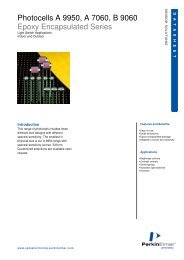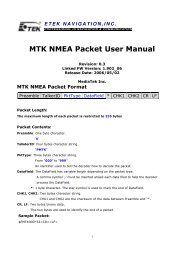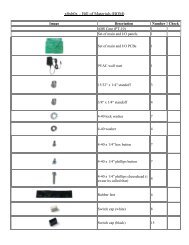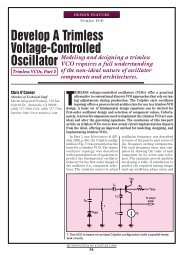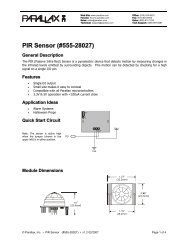Microstrip Patch Antennas for Broadband Indoor Wireless Systems ...
Microstrip Patch Antennas for Broadband Indoor Wireless Systems ...
Microstrip Patch Antennas for Broadband Indoor Wireless Systems ...
Create successful ePaper yourself
Turn your PDF publications into a flip-book with our unique Google optimized e-Paper software.
6.0 PHASE II<br />
6.1 BROADBANDING SCHEMES<br />
Considerable amount of research time was invested in finding a technique that<br />
was easy to implement using adhesive copper tapes as well as projecting a low<br />
manufacturing period and cost. In order to increase bandwidth using thicker substrates<br />
with low ε r [3, Pg-37] was considered. However practical limitation prevents increasing<br />
the height of the substrate since h ≥ 0. 1λ0<br />
, antenna per<strong>for</strong>mance degrades due to<br />
unwanted surface-wave propagations. Stacked Multi-resonators which are<br />
electromagnetically coupled microstrip antennas can also widen BW. The use of ferrite<br />
substrate and the use of log-periodic configurations were also considered. Explained<br />
below are some of the broadband schemes under serious consideration.<br />
- Planar Multi-resonators: the patches are etched close to each other and the gap in<br />
between should not exceed 2h. A single resonator is directly excited while the<br />
others are either parasitically coupled or connected through shorting strips [4,Pg-<br />
89].<br />
- Stacked Electromagnetically coupled patches: similar to the last method but<br />
instead the patches are stacked on top of each other [4, Pg-171]. The patches are<br />
placed on different layers of the dielectric substrates so the total area stays the<br />
same. Different patches are either coupled electromagnetically or aperture<br />
coupled.<br />
- Compact broadband <strong>Microstrip</strong> antennas: since this project aims to develop<br />
antennas <strong>for</strong> the broadband WLAN this model is very important, as ultimately the<br />
antenna real estate needs to be minimized. Increasing the dielectric constant,<br />
which reduces the area but results in reduced BW and gain, does this. Using this<br />
technique the regular shaped patches (rectangle, circle etc) are modified by<br />
inserting posts that act as short circuits [4, Pg-205], thus increasing the BW.<br />
After considerable amount of research and considering the above schemes, the<br />
decision was made to use the parasitically coupled broadband technique. Due to ease of<br />
manufacture using copper tapes, which meant greatly reduced manufacturing time and<br />
flexibility to make alterations quickly to adequately match the input impedance over the<br />
frequency range. The research shows, even though other methods may return higher<br />
bandwidth, the achievable BW using parasitic patches is sufficient to cover the 2.4 - 2.5<br />
GHz frequency band [3, 4].<br />
13




